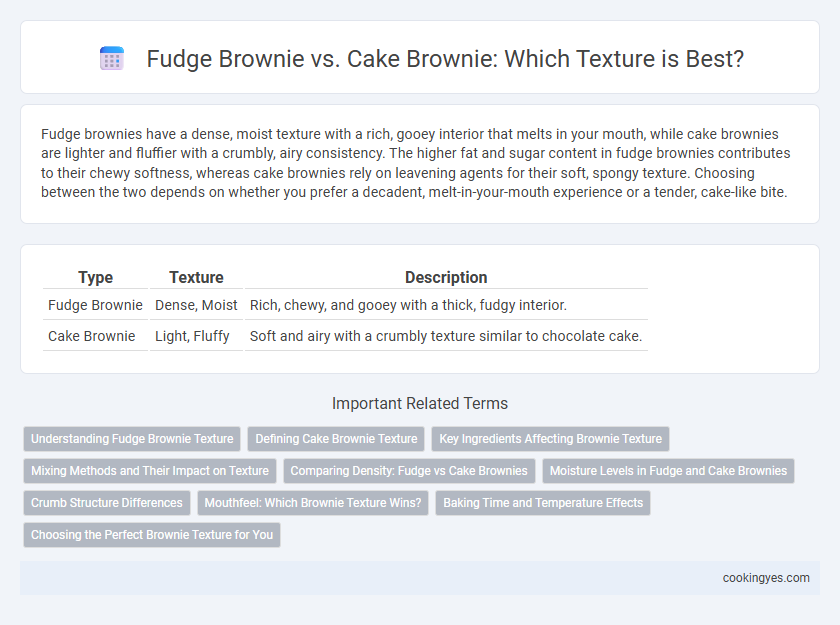Fudge brownies have a dense, moist texture with a rich, gooey interior that melts in your mouth, while cake brownies are lighter and fluffier with a crumbly, airy consistency. The higher fat and sugar content in fudge brownies contributes to their chewy softness, whereas cake brownies rely on leavening agents for their soft, spongy texture. Choosing between the two depends on whether you prefer a decadent, melt-in-your-mouth experience or a tender, cake-like bite.
Table of Comparison
| Type | Texture | Description |
|---|---|---|
| Fudge Brownie | Dense, Moist | Rich, chewy, and gooey with a thick, fudgy interior. |
| Cake Brownie | Light, Fluffy | Soft and airy with a crumbly texture similar to chocolate cake. |
Understanding Fudge Brownie Texture
Fudge brownies have a dense, moist texture characterized by a rich and gooey interior, achieved through higher fat content and less flour compared to cake brownies. The key to understanding fudge brownie texture lies in the balanced ratio of butter, chocolate, and minimal leavening agents, which prevents rising and creates a chewy bite. In contrast, cake brownies incorporate more flour and leavening for a lighter, airy crumb, resulting in a drier and more crumbly consistency.
Defining Cake Brownie Texture
Cake brownies have a light, airy texture achieved by incorporating more flour and leavening agents, which create a fluffy, soft crumb similar to traditional cake. The crumb structure is delicate and spongy, offering a balanced moistness without the dense chewiness found in fudge brownies. This texture makes cake brownies ideal for those who prefer a less rich and more tender dessert experience.
Key Ingredients Affecting Brownie Texture
Fudge brownies achieve their dense, moist texture primarily due to higher fat content from butter and chocolate combined with fewer leavening agents, resulting in a rich, chewy bite. Cake brownies incorporate more flour and baking powder or soda, producing a lighter, airy structure with a cakey, tender crumb. The balance of sugar, eggs, and fat in each recipe critically influences moisture retention and crumb density, defining the final texture of fudge versus cake brownies.
Mixing Methods and Their Impact on Texture
Fudge brownies achieve a dense, moist texture by using minimal mixing and higher fat content, often incorporating melted butter or chocolate that contributes to their rich, chewy consistency. Cake brownies rely on more thorough mixing and leavening agents like baking powder to incorporate air, resulting in a lighter, fluffy texture with a crumb similar to cake. The difference in mixing methods directly affects gluten development and air incorporation, which are key to the contrasting textures of fudge and cake brownies.
Comparing Density: Fudge vs Cake Brownies
Fudge brownies exhibit a dense, moist texture due to higher fat content and less flour, resulting in a rich, chewy bite. Cake brownies contain more flour and leavening agents, producing a lighter, airy structure with a tender crumb. Comparing density, fudge brownies are compact and heavy, while cake brownies have a fluffier, less dense consistency.
Moisture Levels in Fudge and Cake Brownies
Fudge brownies typically have a higher moisture content, resulting in a dense, gooey texture that is rich and chewy. Cake brownies contain less moisture, providing a lighter, more airy crumb that resembles traditional cake with a tender softness. Moisture levels are key to differentiating the signature textures between dense fudge brownies and fluffy cake brownies.
Crumb Structure Differences
Fudge brownies feature a dense, moist crumb with minimal air pockets, resulting in a rich and chewy texture. Cake brownies exhibit a lighter, more aerated crumb structure characterized by a tender and fluffy consistency. The difference in crumb porosity directly influences the mouthfeel, with fudge brownies feeling compact while cake brownies provide a delicate crumb bite.
Mouthfeel: Which Brownie Texture Wins?
Fudge brownies offer a dense, moist texture with a gooey, rich mouthfeel that melts smoothly on the tongue, while cake brownies provide a lighter, airy crumb with a tender bite and subtle crumbly sensation. The choice between the two textures depends largely on personal preference for chewiness versus softness, but fudge brownies consistently deliver a more indulgent, velvety experience favored by chocolate lovers. Texture-wise, fudge brownies win for those seeking an intensely chewy and moist treat, whereas cake brownies appeal to those who prefer a spongier, less dense mouthfeel.
Baking Time and Temperature Effects
Fudge brownies have a dense, moist texture achieved by baking at lower temperatures around 325degF for a shorter time, typically 20 to 25 minutes, which prevents overcooking and maintains their gooey center. Cake brownies require higher baking temperatures near 350degF and longer baking times of 25 to 30 minutes to set the crumb structure, resulting in a lighter, fluffier texture. Adjusting baking time and temperature directly influences moisture retention and crumb density, critical factors distinguishing fudge brownies from cake brownies.
Choosing the Perfect Brownie Texture for You
Fudge brownies feature a dense, moist crumb with a rich, gooey center, perfect for those who prefer a chewy and indulgent texture. Cake brownies offer a lighter, airy bite with a tender crumb, ideal for fans of a more delicate and spongy experience. Selecting between fudge and cake brownies depends on your preference for a decadent, dense treat or a soft, cake-like dessert.
Fudge brownie vs Cake brownie for texture Infographic

 cookingyes.com
cookingyes.com